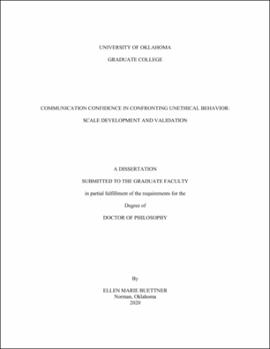| dc.description.abstract | This study describes a new construct, self-perceived communication confidence in confronting unethical behavior (SPC@CUB) as well as develops and validates an original 25-item instrument to measure this construct. This study contributes to the extant literature on communication competence, communication apprehension, organizational ethics, and organizational moral learning, and has implications for the growing literature on bystander intervention training. This investigation followed scholarly recommendations on scale development, which included a pilot study, expert review, exploratory factor analysis, and an assessment of convergent, divergent, and predictive validity with multiple, established measures. It was hypothesized that the SPC@CUB measure would include three facets: apprehension, competence, and voice efficacy. Additionally, it was hypothesized that the SPC@CUB measure would converge with four validated measures: (a) organizational commitment, (b) self-efficacy, (c) communication competence, and (d) experience managing personnel. Additionally, it was hypothesized that the SPC@CUB measure would diverge from three validated measures: (a) personal report of communication apprehension, (b) directness (avoidance-approach), and (c) verbal aggressiveness. Lastly, it was hypothesized that the SPC@CUB measure would predict two variables: (a) group ethical voice and (b) psychological safety.
A pilot sample of full-time working adults (N = 109) participated in the initial survey design instrument, which included 22 items designed to measure communication competence and communication apprehension in confronting minor unethical behavior. As expected, results of the factor analysis indicated the measure was comprised of two factors: communication apprehension and communication competence, with strong reliability ( = .95).
Based on feedback from the pilot study, expert review, and additional literature review, a full-study version of the measure was modified to include a total of 59 items reflecting the constructs of communication apprehension, communication competence, and voice efficacy. In the full study, a sample of full-time working adults (N = 600) was collected. Results of a maximum likelihood analysis revealed a two-factor model related to communication competence and voice efficacy. The final SPC@CUB measure was constituted by 25 items and two subscales (i.e., SPC@CUBcompetence and SPC@CUBfruitful). As hypothesized, one or more of the SPC@CUB measures converged with organizational commitment, self-efficacy, communication competence, and experience managing personnel; the new measure demonstrated discriminant validity with communication apprehension, unwillingness to communicate, verbal aggressiveness and predicted group ethical voice and psychological safety.
This study contributes to organizational communication research in several ways: First, this study contributes further evidence to the communication competence literature that speech context is influential in determining one’s self-perceived communication competence. Second, this study contributes to the organizational moral learning literature the idea that practicing difficult discussions involving ethical confrontation may result in greater organizational moral learning capacity by bolstering self-perceived communication competence in confronting unethical behavior. Third, these results contribute to the bystander intervention literature the implication that SPC@CUBcompetence may need to be trained in tandem with bystander intervention training to maximize the training strategy’s effectiveness. Fourth, these findings contribute to the organizational communication literature the idea that the SPC@CUB constructs have important implications for creating and sustaining ethically excellent organizational culture. Lastly, this investigation contributes to the communication competence and communication anxiety literature based on the idea that communication competence may ameliorate the anxiety-producing event of confronting a co-worker about his or her unethical behavior. This study concludes with future directions for research, practical implications, and limitations. | en_US |
